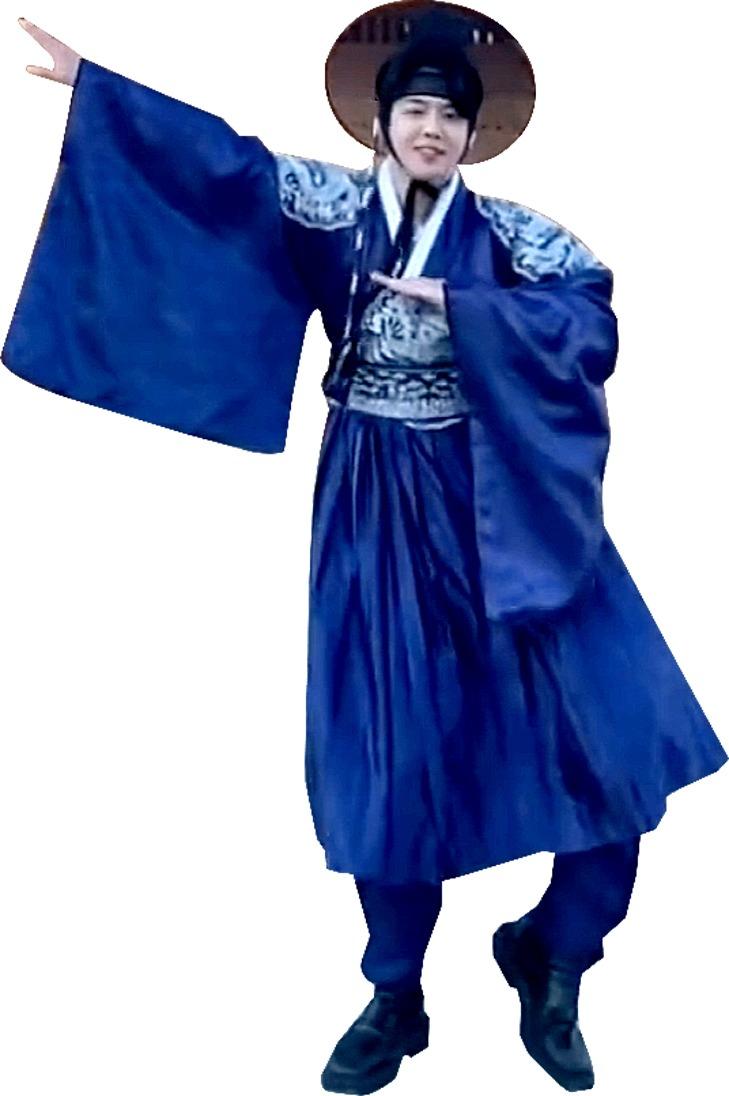Joyful and exuberant, new phenomenon goes viral, provides better understanding of nation's pop culture
 Pamela Reif, a German fitness influencer, posted a video of herself dancing the kemusan on Dec 21, 2023 on Bilibili, a video platform. (PHPOTO / BILIBILI)
Pamela Reif, a German fitness influencer, posted a video of herself dancing the kemusan on Dec 21, 2023 on Bilibili, a video platform. (PHPOTO / BILIBILI)
When YJIN, a leading dance influencer in South Korea, saw the kemusan dance challenge trending online, she immediately decided to film videos of her own.
With her sharp and fluent moves, the videos have received more than 20 million views since being posted in mid-December and are among the most popular in South Korea.
Kemusan means "subject three "in Mandarin, and there are several theories on the origin of the name.
A professional dancer with more than 20 years' experience and the content creator of the "Fast Dance Official" YouTube channel, YJIN said the strong beats and repetitive moves of kemusan dance, also known as Haidilao Naruto dance in South Korea, make it easy for anyone to follow.
"The interesting hand gestures, which look like ninja Naruto (from the Japanese manga series of the same name), also trigger people's desire to follow the dance moves," YJIN said.
READ MORE: Check out the crews for some inspired street moves
The viral Chinese street dance has become an internet sensation, attracting billions of views in China and overseas.
Despite being considered "vulgar "by some, videos of employees at the Chinese hot pot chain Haidilao dancing the kemusan to entertain customers gained popularity last November on social media platforms such as Douyin, YouTube, and X(formerly Twitter).
Since then, people from various dance backgrounds, both professional and amateur, have flooded social media with short videos showing them twisting and jerking their limbs, flicking their wrists and swinging from side to side to the catchy beats of the Chinese song Yi Xiao Jiang Hu, or Laugh at the World.
 A young woman in Italy performs the dance. (PHOTO / FACEBOOK)
A young woman in Italy performs the dance. (PHOTO / FACEBOOK)
Global phenomenon
According to videos on social media, multiple World Latin American dance champion Joanna Leunis performed the kemusan at the World DanceSport Federation GrandSlam in Shanghai last December.
Elsewhere, dancers from a Russian ballet troupe took a curtain call and sprung into the kemusan after a Swan Lake performance in Northeast China's Liaoning province in December, while South Korean boy band Enhypen did the dance during their Macao concert in January.
The reason behind kemusan going viral is partially due to the influence of Haidilao as a global brand, said Chen Lou, associate professor at the Wee Kim Wee School of Communication and Information at Nanyang Technological University (NTU) in Singapore.
"They incorporated this viral dance into their dance routine and made it more widely known to people overseas via social media and offline," said Lou.
There are many theories on the origin of the kemusan dance and its name.
The term kemusan refers to subject three of China's driving test, the practical road driving skills test for obtaining a license. One explanation circulating online is that a young man did the dance after passing his driving test so people named the dance kemusan.
Another explanation circulating online is that the dance routine was first performed by people attending a wedding in the Guangxi Zhuang autonomous region. Some netizens joked that everyone born in Guangxi needs to pass three subjects in their lives — singing folk songs, eating rice noodles, and dancing.
A village boy named Xiao Ming from Sichuan province claimed Douyin to be the original choreographer of the kemusan. His dance videos have attracted 6 million followers and nearly 80 million likes.
The large number of videos and their wide circulation makes it difficult to trace the origin of the dance. However, to young people following the trend, this is no longer important as they just see kemusan as a way to de-stress and share happiness.
 A dancer dressed in a South Korean hanbok performs the kemusan. (PHOTO / TIKTOK)
A dancer dressed in a South Korean hanbok performs the kemusan. (PHOTO / TIKTOK)
The right moves
In a 30-second tutorial video, YJIN demonstrates how to easily learn kemusan and many of her followers left comments saying that they have successfully mastered the dance.
"The most important point of the dance is to press the tiptoes and heels properly and move from side to side like a tumbler," said YJIN.
However, YJIN warned people should be careful dancing kemusan as they might sprain their ankles or knees if they try to imitate the moves without paying attention to the right techniques. "People who want to try the dance should not force their ankles to twist unnaturally," said YJIN.
In Thailand, people are enjoying kemusan both online and offline. In popular Haidilao branches in Bangkok, some diners liked the catchy dance so much that they joined the staff in performances.
The accompanying song, which sounds like a mix of disco beats and traditional Chinese folk songs, has also been widely embraced by Thai college students.
During February's Lunar New Year celebration, nearly 60 students from Silpakorn University in Bangkok dressed up in the traditional attire of some Chinese ethnic groups and performed the kemusan dance. The dance was an instant sensation online in Thailand.
On TikTok, one kemusan video by a Thai girl using an account named Poppok9 has been viewed more than 167,000 times.
Vachirapol Prommalikit, a sophomore at Chulalongkorn University in Bangkok, said the "subject three" dance has been popular in Thailand for some time.
"I saw it for the first time on TikTok and was taken by its beat," he said. "After learning the song's name, I researched it online and found many young people performed the dance and some had even developed their own styles."
 YJIN is an influencer who teaches her followers the dance moves. (PHOTO / INSTAGRAM)
YJIN is an influencer who teaches her followers the dance moves. (PHOTO / INSTAGRAM)
Unique style
Vachirapol said the "subject three" dance has a unique style as the moves change rapidly and it requires good physical coordination to follow the actions, such as swinging the knees sideways, a rapid series of hand actions, or fast twisting of the wrists.
Thailand has songs similar to the mesmerizing ones used in kemusan. "I think this music style is welcomed by young people, in particular, due to its fun elements and liveliness," he said.
Vachirapol's classmate, Supasan Chaipanit, tried to master the dance after being attracted by its fun moves and popularity.
"It's not easy to perform the dance well, although most of the moves are easy to follow. But still, it is not difficult to perform a short part of it, even for those who have never learned dance before. Everyone can enjoy the dance. I think that's the charm of the 'subject three' dance," Supasan said.
In Singapore, students at the Canadian International School (CIS) put on sunglasses and dressed in red shirts to perform kemusan during Chinese New Year celebrations.
Charlotte Hewson, marketing and communications manager of CIS Singapore, said a group of students initiated the idea after seeing the videos online." (They) thought it would be a fun way to continue the many Lunar New Year festivities and celebrations that take place within the school that bring our community together," said Hewson.
Lou, from NTU, said the students' dance showed that they want to be part of a cultural trend. "It also denotes their cultural identity," Lou added.
Peh Lei Xi Crystal, a part-time Zumba instructor and dance teacher in Singapore, combined kemusan moves with Zumba in a fitness routine.
"I first saw the video on TikTok and I thought the music has a strong Chinese style," said Peh. "At first I did not like the music, but after listening to it a few more times and seeing the dance moves, I began to think it is interesting."
Peh said many of her students, particularly the younger generation with Chinese ancestry, liked the dance after she introduced it to them.
"Recently, I also shared the music with a group of Malay Singaporeans. The reaction was nice but it seems that they did not know what the 'subject three' dance is," said Peh.
Noting that about 70 percent of Singapore's population is ethnically Chinese, Peh said it is easier for people to accept popular trends from China like kemusan.
Peh said the power of short video platforms, the dissemination by overseas Chinese, and the simple dance choreography are reasons why the kemusan dance can take the world by storm.
 This screenshot captured from a video shows people learning "Kemusan" dance at a street dance training studio in Nanning, south China's Guangxi Zhuang Autonomous Region, Dec 20, 2023. (PHOTO / XINHUA)
This screenshot captured from a video shows people learning "Kemusan" dance at a street dance training studio in Nanning, south China's Guangxi Zhuang Autonomous Region, Dec 20, 2023. (PHOTO / XINHUA)
Emotional release
The dance has been widely spread via social media in the form of short videos.
"The kemusan dance itself is a lot of joy and fun that can be recognized by people worldwide. Young people, in particular, can find in the dance a free and delightful way to express themselves in a positive way," said Yu Haiqiu, director of Yunnan Academy of Social Sciences' Thailand Research Institute.
"The dance meets the emotional needs of many people and helps release their feelings. Some kemusan dance videos have been performed in public places, which shows the attitude of young people who want to be independent and are not afraid of others' opinions," Yu said.
Yu attributed the global popularity and mass participation in kemusan to its free and easy style.
"It's not hard to learn and get everyone engaged. Some people have even developed their own style of kemusan to make the performance unique and personal," she added.
Younger generations, especially those born after the 1990s and 2000s, are more deeply involved with the internet and social media, Yu said.
"The internet helps to bridge the geographical gap and gives individuals a stage to express themselves. Everyone has a chance to be under the spotlight, and dancing is one of the ways to perform," she said. "This kemusan dance trend helps to bring people from around the world with different backgrounds even closer, which is very encouraging."
ALSO READ: Taking street dance to campus
Veronika Saraswati, convener of the China Studies Research Unit at the Jakarta-based Centre for Strategic and International Studies, said the "subject three" dance is an energetic and enjoyable dance that is inspiring togetherness, cooperation and harmony.
"Therefore, many people love it," she said.
Besides the "subject three "dance, Saraswati said other areas of Chinese popular culture such as TV dramas are also growing in global popularity.
"Popular culture is a window for people around the world to understand Chinese culture comprehensively," said Saraswati. "China's great achievements in advanced technology and innovation benefit and support these cultural works."
Ellis Ng in Singapore and Jin Mengzhe in Bangkok contributed to this story.
Contact the writers at kelly@chinadailyapac.com


